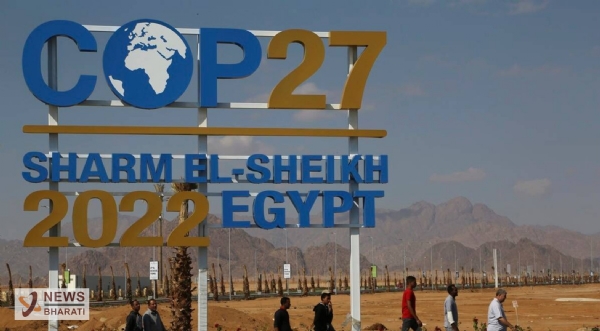COP27- Way Forward for India
Climate change is the biggest concern for the world. To mitigate the climate change there are several international efforts being taken at the same time. COP is one such conference happening every year. This year"s COP27 concluded few days back. Let"s have a look why it was historic?
Total Views | 81
On 19th November 2022, i.e., one day after the scheduled conclusion, the Conference of Parties (COP27) ended. One of the most significant achievements for the global south is the approval of the ‘Loss & Damage Fund’. It is seen as an important tool in the adaptation to the climate crisis, and many developing nations were looking forward to it. After the conference what could be India’s future steps? What has India had on its plate through Nationally Determined Goals and what is India doing now? In this article, we will try to have glimpses of COP and COP27.

What is COP?
COP stands for ‘Conference of Parties’. The world had set up various organisations to tackle the problem of climate change. United Nations Framework Convention on Climate Change (UNFCCC) is one such effective institutional set-up and COP is its main decision-making body. It includes the representatives of all the countries that are signatories (or ‘Parties’) of UNFCCC.
Also Read: “We need to take every action at the same time”- Suresh Prabhu
COP revolves more around discussions and debates, through which parties review the overall progress of the UNFCCC: to limit climate change. Sometimes, COP can reach a new historic agreement, decision etc. like the Kyoto Protocol or the decision of the ‘Loss and Damage Fund’ in COP27, Egypt.
Mitigation and Adaptation
‘Mitigation and Adaptation’ were the buzzwords during COP27. Both these terms are necessary to understand when we discuss environmental issues.
Mitigation- Conceptually mitigation means curbing the carbon emission in future. It includes taking the required actions to keep the goal of 1.5°C alive. During Paris Agreement, the nations submitted their Nationally Determined Contributions (NDC) to achieve this target.
In COP27 parties agreed upon keeping global warming below 1.5°C and taking immediate actions. The major task of reducing Green House Gas (GHG) emissions by 43% by 2030 as compared to 2019 levels was also accepted.
Adaptation- Another term which comes with mitigation is ‘Adaptation’. Adaptation is accepting climate change. India’s ex-cabinet Minister of Energy, Mr Suresh Prabhu in an online session organised by ‘The Sustainability Foundation- Denmark’, explained that current climate change is because of historic emissions. The contributors to this emission are primarily industrialised countries and developing countries have contributed very less to it- because they were not industrialised.
Also Read: Infant Mortality Rate and Women Literacy
Adaptation requires resources because it requires lifestyle changes. People need to accept climate change and adopt an eco-friendly lifestyle. It brings various changes in various aspects of life from livelihood to various day-to-day activities. Most of the climate-vulnerable nations need to adopt climate change and are required to change their lifestyle, which requires a huge amount of money and investment. Here is where the ‘Loss and Damage Fund’ comes into play.
Loss and Damage Fund
‘Loss and Damage Fund’ was a matter of concern for many countries vulnerable to climate change. The loss and damage fund has a long history and was the most awaited decision for many developing and underdeveloped countries, especially for island nations which are the most prone to losses caused by the increase in sea levels.
In a briefing paper published by ‘Stockholm Environment Institute’ in October 2021, by Zoha Shawoo et.al. loss and damage have been defined. It says,
“Loss and damage (L&D) refer to impacts of climate change that cannot (or have not) been avoided through mitigation or adaptation. The world’s poorest and least-developed countries, which have contributed very little to global greenhouse gas emissions, face many of the worst impacts: from extreme weather events such as hurricanes to slow-onset events such as sea-level rise that are gradually rendering places uninhabitable. These impacts not only threaten human rights but also limit countries’ ability to pursue development goals such as poverty reduction, health, and food and water security”
As said above, the current climate crisis is mostly because of the historic emissions around the 20th century by a few countries like the UK, France, Germany, Canada, and the US. This has put low-lying and coastal developing countries such as Mauritius, Seychelles, the Maldives, Samoa, Palau, etc. The principle aims at sudden natural calamities like cyclones, hurricanes, etc as well as long-term effects of climate change, ex. Rise in sea level etc.
Also Read: India’s Green Energy Story
The idea of the loss and damage fund was pushed by the ‘Alliance of Small Island States (AOSIS)’ for the first time in the year 1991. Since then, it has been in discussion in various meetings. During COP19 which was held at Warsaw, Poland in November 2013 the ‘Warsaw International Mechanism’ for loss and damage associated with climate change was established. Later it became a part of the Paris Agreement. It was included in Article 8 of the Paris Agreement, where areas of cooperation and facilitation to enhance understanding, action and support were identified, which were as follows:
a) Early warning systems
b) Emergency preparedness
c) Slow onset events
d) Events that may involve irreversible and permanent loss and damage
e) Comprehensive risk assessment and management
f) Risk insurance facilities, climate risk pooling and other insurance solutions
g) Non-economic losses
h) Resilience of communities, livelihoods and ecosystems
What’s in COP27 for Loss and Damage?
Loss and damage were also a hot topic during COP26, Glasgow. This year it was the central topic for COP27. On Sunday, nations agreed upon setting up a fund to help poor countries hit by a warming planet.
Also Read: Forest Cover in India: Some facts
The primary contributors to the fund would be developed nations along with some private parties. Other major economies may join as a contributor down the line. At the same time, the words ‘Identifying and expanding sources of funds’ are also included in the final text. This was majorly pushed by the EU and the US suggesting that countries which are high-polluting and developing at the same time should also contribute to the fund.
Benefiting countries would be “developing countries that are particularly vulnerable to the adverse effects of climate change”. Pakistan, which was devasted by floods and nearly one-third of the country was under water or Cuba which was badly hit by hurricane Ian could be eligible.
Key Takeaways and India
This COP has been historic particularly in terms of the loss and damage issue. Parties agreeing upon setting up the loss and damage fund is an achievement in itself. Looking at the complexity of the fund structure, it is hard to make a statement if India would be benefiting or contributing state.
Also Read: India’s journey from milk-deficient country to milk exporter
As the data shows, CO2 emissions are less than Europe and Central Asia and the USA alone and China. In fact, emissions by China shot up around 2001 whereas India’s carbon emission is increasing nearly at a constant pace.
At the same time, India has an ambitious target of becoming net zero by 2070. Being the second largest populated country and one the fastest growing economies of the world India’s energy requirements are changing drastically. Currently, India is focusing more on electrification for railways as well as promoting EVs in the Indian market. Therefore, it is going to be a very skillful task for the government of India to navigate through this tough situation. We will see what India’s current energy situation and environmental challenges related to it in next articles.




